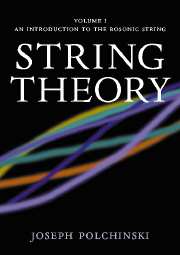Book contents
- Frontmatter
- Contents
- Foreword
- Preface
- Notation
- 1 A first look at strings
- 2 Conformal field theory
- 3 The Polyakov path integral
- 4 The string spectrum
- 5 The string S-matrix
- 6 Tree-level amplitudes
- 7 One-loop amplitudes
- 8 Toroidal compactification and T-duality
- 9 Higher order amplitudes
- Appendix A: A short course on path integrals
- References
- Glossary
- Index
1 - A first look at strings
Published online by Cambridge University Press: 29 March 2011
- Frontmatter
- Contents
- Foreword
- Preface
- Notation
- 1 A first look at strings
- 2 Conformal field theory
- 3 The Polyakov path integral
- 4 The string spectrum
- 5 The string S-matrix
- 6 Tree-level amplitudes
- 7 One-loop amplitudes
- 8 Toroidal compactification and T-duality
- 9 Higher order amplitudes
- Appendix A: A short course on path integrals
- References
- Glossary
- Index
Summary
Why strings?
One of the main themes in the history of science has been unification. Time and again diverse phenomena have been understood in terms of a small number of underlying principles and building blocks. The principle that underlies our current understanding of nature is quantum field theory, quantum mechanics with the basic observables living at spacetime points. In the late 1940s it was shown that quantum field theory is the correct framework for the unification of quantum mechanics and electromagnetism. By the early 1970s it was understood that the weak and strong nuclear forces are also described by quantum field theory. The full theory, the SU(3) × SU(2) × U(1) Model or Standard Model, has been confirmed repeatedly in the ensuing years. Combined with general relativity, this theory is consistent with virtually all physics down to the scales probed by particle accelerators, roughly 10−16 cm. It also passes a variety of indirect tests that probe to shorter distances, including precision tests of quantum electrodynamics, searches for rare meson decays, limits on neutrino masses, limits on axions (light weakly interacting particles) from astrophysics, searches for proton decay, and gravitational limits on the couplings of massless scalars. In each of these indirect tests new physics might well have appeared, but in no case has clear evidence for it yet been seen; at the time of writing, the strongest sign is the solar neutrino problem, suggesting nonzero neutrino masses.
Information
- Type
- Chapter
- Information
- String Theory , pp. 1 - 31Publisher: Cambridge University PressPrint publication year: 1998
